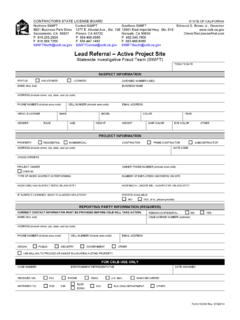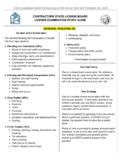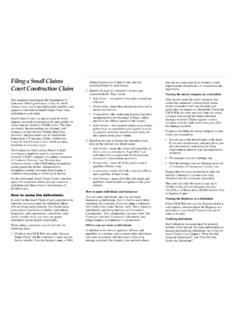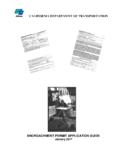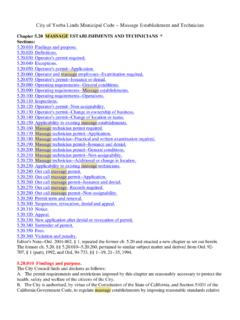Transcription of Penalties for Misclassifying Workers as …
1 Penalties for Misclassifying Workers as independent Contractors Misclassification of Workers as independent contractors rather than employees can carry serious consequences for your nonprofit organization. The classification of Workers affects tax liability, as well as standards of employment1. A new California law, California Labor Code Section , adds another important consequence of determining the relationship between an employer and a worker . Section , which went into effect on January 1, 2012, imposes new Penalties on employers for incorrectly classifying Workers as independent contractors.
2 In addition to state-imposed Penalties , employers continue to face federal Penalties under the IRS Code. This alert provides some guidance in classifying your Workers , discusses the implications of the new California law, and offers suggestions about and what you can do to avoid liability. What is California Labor Code Section California Labor Code Section imposes new Penalties on employers who willfully misclassify their employees as independent contractors. Willful misclassification is defined as voluntarily and knowingly Misclassifying that individual as an independent contractor .
3 The law also penalizes employers who charge fees or make deductions from compensation to an individual who has been willfully misclassified as an independent contractor . Courts have not had the opportunity to provide practical guidance on what constitutes voluntarily and knowingly Misclassifying Workers under Section However, a well-reasoned good faith misclassification would likely fall short of the standard. Conversely, intentionally flying just below the right to control standard (discussed immediately below) may constitute willful misclassification.
4 1 This alert focuses only on Penalties imposed for Misclassifying Workers , and not other issues associated with classification of Workers . How do I determine whether a worker is an employee or an i ndependent contractor ? The common law test to determine whether a worker is an employee or independent contractor is imprecise and requires an analysis of several factors of the employer- worker relationship. These factors must be weighed against each other and considered in light of the total circumstances.
5 They include: 1) Who has the right to control the worker s manner and means of performing his or her duties an independent contractor has more control over the day-to-day details of his or her job than an employee; 2) The skill required in the worker s job independent contractors often perform highly skilled jobs; 3) Whether the worker is engaged in a distinct business or occupation if the worker is engaged in a distinct business or occupation, it is more likely the worker is an independent contractor ; 4) Whether the work is done under supervision the more an employer is directly supervising the worker , the more likely he or she is an employee; 5) Whether the worker can be discharged at will or for cause allowing discharge at will often weighs in favor of an employer-employee relationship.
6 6) Who supplies the tools, instrumentalities and place of work if the worker supplies these, he or she is more likely an independent contractor ; 7) The length of time the services are to be performed discrete jobs are generally performed by independent contractors; 8) The method of payment, whether by time or by the job payment by time generally signals an employee relationship; 9) Whether the work is part of the regular business of the principal if it is, the worker is more likely an employee; 10) Whether the parties subjectively believe they are creating an employer-employee relationship.
7 See S. G. Borello & Sons, Inc. v. Dep t of Indus. Relations, 48 341, 350-51 (1989); 38 Cal. Jur. 3d independent Contractors 3. Though not dispositive, the most important factor in the analysis is who has the right to control the worker s manner and means of performing his or her work. This i s referred to as the right to control test. A few examples may help illustrate the application of the test: A cleaning maid who worked in the home of her employers and charged $16 per day was found by a court to be an employee of one of her employers who asked her to clean a vacant apartment he managed.
8 The court found the maid an employee because the employer brought her to the apartment, told her what to clean, and provided her with cleaning equipment to complete the job. Johnson v. Workmen's Comp. Appeals Bd., 41 Cal. App. 3d 318 (1974). A carpenter was found to be an independent contractor even though he was paid by the hour in Germann v. Workers ' Comp. Appeals Bd., 123 Cal. App. 3d 776 (1981). The most important factor in the court s analysis was the right to control the employer did not instruct the worker on how to complete the job, he was only concerned about the outcome of the project.
9 Finally, a writer was considered an independent contractor of a magazine publisher where the publisher did not control the means and manner by which the writer wrote the story. Although the publisher thoroughly edited and revised the article and had final say over the finished product, the court found that the employer did not exert the level of control that characterizes an employer-employee relationship. Additionally, the court was persuaded by the fact that the writer was paid by the job, did not work on the publisher s premises, and that his job required great skill.
10 America v. Rolling Stone Magazine, 101 F. Supp. 2d 1270 (2000). For federal tax purposes, the IRS uses three tests to determine worker classification: the behavioral control test, the financial control test, and the relationship between the parties. These tests consider factors similar to the common law test described above, also focusing on the right to control factor. Who are statutory employees? Some Workers are statutory employees under both federal and California law. These Workers must be classified as employees, even if they would be considered independent contractors under the common law test.

